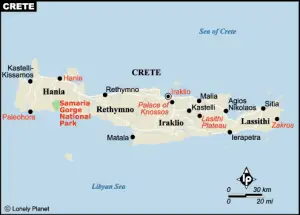The palace of Knossos was the stage for a plethora of fascinating myths in ancient Greece. The Minoan king lived in the capital city of Knossos, in a maze of a place with 1500 rooms! It was a gorgeous palace.
Knossos Labyrinth
The palace of grandest of the four Minoan palaces that have been unearthed in Crete and its complex architecture has been identified as the legendary “Labyrinth”.

Palace of Knossos facts
Knossos was the site of a Neolithic, or New Stone Age, settlement before 3000 B.C. The city became a center of the wealthy Minoan civilization, and its merchants traded throughout the eastern Mediterranean Sea.
It was severely damaged by an earthquake about 1600 B.C. but was rebuilt. It was destroyed around 1400 B.C., probably by invading Achaean Greeks from the mainland.
The Palace of Knossos is the largest of the preserved Minoan palatial centers. Four wings are arranged around a central courtyard, containing the royal quarters, workshops, shrines, storerooms, repositories, the throne room, and banquet halls. Dated to 200-1350 B.C.

A Native of Crete
The first archaeologist who excavated Knossos was (the appropriately named) Minos Kalokairinos who was a native of Crete and had already dug a few areas of the palace before Evans, unearthing in the process a wealth of artifacts that proved the existence of a previously unknown civilization.
Kalokairinos began excavating Knossos in 1878, and he exposed to other areas part of the antechamber of the Throne room with its red frescoes.
Assisted by Dr. Duncan Mackenzie, who had already distinguished himself by his excavations on the island of Melos, and Mr. Fyfe, the British School of Athens architect, Evans employed a large staff of excavators and by June of 1900 had uncovered a large portion of the palace.
At Knossos, the Minoans took advantage of the steep grade of the land to devise a drainage system with lavatories, sinks, and manholes. Archaeologists have found pipe laid in depths from just below the surface in one area to almost 11 feet deep in others.

One of the remarkable discoveries at Knossos was the extensive murals that decorated the plastered walls. All were very fragmentary and their reconstruction and re-placement into rooms by the artist Piet de Jong are not without controversy.
At Knossos, we find the earliest known flushing toilet. The toilet was screened off by partitions and was flushed by rainwater or by water held in cisterns from conduits built into the wall. Not just palaces but ordinary homes were heated with sophisticated hypocaust systems, where heat was conducted under the floor, the earliest known to exist.